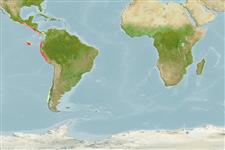Environment: milieu / climate zone / depth range / distribution range
Ecología
marino demersal; rango de profundidad 35 - 600 m (Ref. 82251), usually 251 - 300 m (Ref. 82251). Subtropical; 24°N - 47°S, 107°W - 74°W
Eastern Pacific: distribution is not precisely known; but may extend from Mazatlán, Mexico to Chile.
Tamaño / Peso / Age
Maturity: Lm ? range ? - ? cm
Common length : 35.0 cm TL macho / no sexado; (Ref. 9330)
Espinas dorsales (total): 0; Radios blandos dorsales (total): 64-73; Espinas anales 0; Radios blandos anales: 52 - 58. Pectoral fins rather small, about 2 times in head in ocular side and about 2.5 times in head on blind side. Pelvic fin on ocular side slightly larger than on blind side. Caudal fin round. Body brownish, with obscure darker spots on body and fins (Ref. 27363).
This species inhabits soft bottoms (Ref. 9330); from the littoral zone (35 m, shallowest depth reported in Ref. 9330) up to 600 m (Yañez and Barbieri, 1974.in Ref. 82251:833). Common depth range was taken from a study done in northern Chile. Stomach contents include mainly the squat lobsters (Pleuroncodes monodon and Cervimunida johni) and the deep-sea shrimp (Heterocarpus reedi) (Ref. 82251). Exploited on a local level with trawl nets and is utilized fresh or as fishmeal.
Life cycle and mating behavior
Madurez | Reproducción | Puesta | Huevos | Fecundidad | Larva
Distinct pairing (Ref. 205).
Hensley, D.A., 1995. Paralichthyidae. Lenguados. p. 1349-1380. In W. Fischer, F. Krupp, W. Schneider, C. Sommer, K.E. Carpenter and V. Niem (eds.) Guia FAO para Identification de Especies para lo Fines de la Pesca. Pacifico Centro-Oriental. 3 Vols. FAO, Rome. (Ref. 9330)
IUCN Red List Status (Ref. 130435)
Threat to humans
Harmless
Human uses
Pesquerías: escaso valor comercial
Más información
Age/SizeCrecimientoLength-weightLength-lengthLength-frequenciesMorfometríaMorfologíaLarvaDinámica larvariaReclutamientoAbundanciaBRUVS
ReferenciasAcuiculturaPerfil de acuiculturaRazasGenéticaElectrophoresesheritabilidadEnfermedadesProcesamientoNutrientsMass conversion
Herramientas
Special reports
Download XML
Fuentes de Internet
Estimates based on models
Preferred temperature (Ref.
123201): 10.9 - 12, mean 11.4 °C (based on 7 cells).
Phylogenetic diversity index (Ref.
82804): PD
50 = 0.5078 [Uniqueness, from 0.5 = low to 2.0 = high].
Bayesian length-weight: a=0.00724 (0.00346 - 0.01519), b=3.17 (2.99 - 3.35), in cm total length, based on LWR estimates for this (Sub)family-body shape (Ref.
93245).
Nivel trófico (Ref.
69278): 3.7 ±0.3 se; based on diet studies.
Resiliencia (Ref.
120179): Alto, población duplicada en un tiempo mínimo inferior a 15 meses (Preliminary K or Fecundity.).
Fishing Vulnerability (Ref.
59153): Low to moderate vulnerability (26 of 100).
Nutrients (Ref.
124155): Calcium = 461 [145, 1,393] mg/100g; Iron = 1.46 [0.59, 3.70] mg/100g; Protein = 16.2 [13.8, 18.5] %; Omega3 = 0.409 [0.142, 1.201] g/100g; Selenium = 14.4 [4.0, 51.4] μg/100g; VitaminA = 114 [18, 780] μg/100g; Zinc = 1.81 [0.93, 3.31] mg/100g (wet weight);
